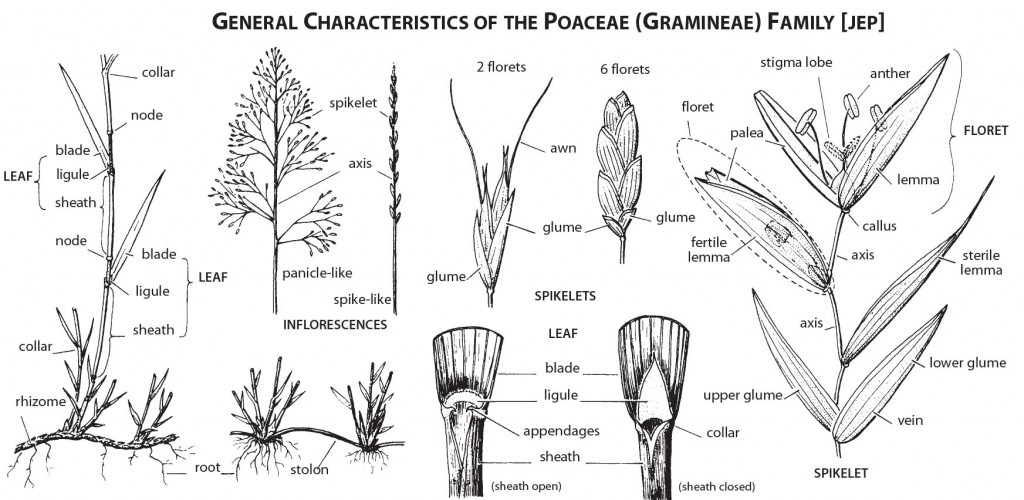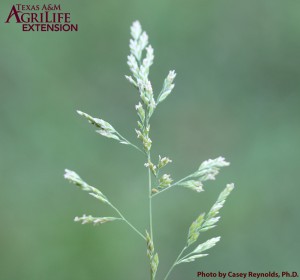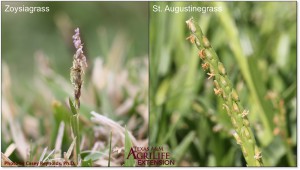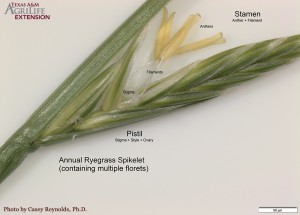Turfgrass Identification and Selection
Casey Reynolds, PhD
There are over 10,000 species of grasses in the Poaceae family and over 700 species of grasses found in Texas. Many of these species serve as a source of food, forage, biofuels, soil and land conservation, and ornamentals. However, there are also at least 12 species that are widely used as turfgrasses. These often serve as perennial ground covers in home lawns, athletic fields, golf courses, roadsides, etc. While many of these turfgrass species share similar characteristics, there are distinguishing factors among each species that often make them unique. In order to properly identify each of these species it is first important to understand basic turfgrass morphology and growth as well as how this may impact identification and selection.
Turfgrasses tolerate mowing because of the position of their growing point at the top of an un-elongated stem called the crown. This is a region of actively dividing cell tissue that results in the growth of turfgrass leaves, which occurs near the soil surface. As long as vegetative growth continues, newly formed leaves will continue to be formed at the crown and will replace older leaf tissues as they are mowed off of the plant.
As these leaves emerge, they form into two parts; the blade and the sheath. The blade is the unfolded or unrolled part of the leaf while the sheath is the lower portion of the leaf, which attaches it to the rest of the turfgrass plant. Other characteristics of leaves listed in Figure 1 that can be useful in identifying turfgrass species include vernation, ligules, auricles, and collars.

In addition to leaves, the turfgrass crown also has the ability to produce tillers. All turfgrass species have this ability, and it is one of the primary features that allow them to produce dense turfgrasses from single seeds. However, in addition to these tillers many species of grasses also have secondary lateral stems called rhizomes or stolons. Rhizomes are below-ground lateral stems while stolons are above-ground lateral stems. These features are important components of many turfgrasses because they allow them to tolerate and recover from stresses such as traffic, divots, drought, or injury from insects or diseases.
Many fescues and ryegrasses have a bunch-type growth habit while Buffalograss, Creeping bentgrass, St. Augustinegrass, and Centipedegrass have stoloniferous growth habits, and Kentucky bluegrass and some species of Fine fescue have a rhizomatous growth habit. Bermudagrass, Seashore paspalum and Zoysiagrass have both rhizomes and stolons, which is one of the features that often make them hardy in high-traffic settings.
The final and most significant feature used to identify turfgrasses is the inflorescence, or flowering portion of the grass plant (Figure 2). There are many variations of the grass inflorescence, but they are all placed into one of three different categories: the spike, the raceme, and the panicle.


Hickman, J.C. ed. 1993. The Jepson manual: Higher plants of California. University of California Press, Berkeley. Reprinted from The Jepson manual, J. Hickman, Ed., 1993, with permission from the Jepson Herbarium. © Regents of the University of California.
The most common inflorescence in grasses is the panicle, which can be found in various forms. Many cool-season grasses such as bluegrasses, bentgrasses, and fescues have a panicle inflorescence with multiple levels of branching and re-branching (Figure 3).
However, panicles can also consist of various spicate branches that extend away from the central axis, as in the case of seashore Paspalum and Bermudagrass (Figure 4). Annual ryegrass, Perennial ryegrass,

St. Augustinegrass and Zoysiagrass are all examples of Spike/Spicate/Spike-like inflorescences where the flowering bodies are directly attached to the central axis (Figure 5). Regardless of the type of inflorescence present in a particular grass species, the basic unit of the inflorescence is the spikelet and the basic unit of the spikelet is the floret (Figures 2 and 6). Florets are reduced flowers that can be perfect, staminate, pistillate, or sterile. turfgrass species have various degrees of self-incompatibility and therefore rely on cross-pollination for fertilization of their flowers. This is one of the factors contributing to the high variability that exists in grasses.


Vegetative and flowering characteristics of turfgrasses are extremely important tools for proper identification, because turfgrasses can often exhibit differences in appearance based on management and environmental factors such as mowing, fertility, temperature, shade, etc. While it is common for turfgrasses to demonstrate minor changes in leaf texture, density, color, etc., vegetative and flowering characteristics remain much more constant and useful when identifying turfgrass species. For specific information on turfgrasses adapted for Texas, please click on each of the turfgrass species listed below in Table 1.
| Table 1. Texas Turfgrasses | |
|
Warm-season Species |
Cool-season Species |
| Bermudagrass | Annual ryegrass |
| Buffalograss | Creeping bentgrass |
| Centipedegrass | Fine fescue |
| Seashore Paspalum | Kentucky bluegrass |
| St. Augustinegrass | Perennial ryegrass |
| Zoysiagrass | Tall fescue |
References Cited
Shaw, R.B. 2012. A Guide to Texas Grasses. Texas A&M University Press. College Station, TX.
Turgeon, A.J. 1996. Turfgrass Management. 4th edition. Prentice-Hall, Inc. Upper Saddle River, NJ.
